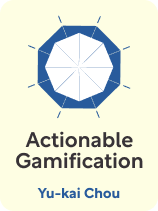

This article is an excerpt from the Shortform book guide to "Actionable Gamification" by Yu-kai Chou. Shortform has the world's best summaries and analyses of books you should be reading.
Like this article? Sign up for a free trial here.
Looking for an overview of Actionable Gamification by Yu-Kai Chou? Why are businesses turning to game mechanics to motivate customers and employees?
Games have the power to unlock deep reserves of human motivation that drive customer and employee behavior. In Actionable Gamification, Yu-Kai Chou explains why many businesses that try to incorporate game elements into their business strategy end up failing.
Keep reading for a brief overview of Actionable Gamification by Yu-Kai Chou.
Actionable Gamification by Yu-Kai Chou
In Actionable Gamification, Yu-Kai Chou explains that games have the power to unlock deep reserves of motivation and potential while making seemingly mundane or repetitive activities enjoyable. Consider how much willpower and effort it takes most people to get through their workday, finish their chores, or stick to an exercise routine. Now reflect on how little effort it takes someone absorbed in a game to continue playing—they repeatedly overcome difficult challenges for no other reason than that they enjoy it.
This is why so many businesses are trying to incorporate game mechanics into their product, marketing, or management. By understanding what motivates people to play, business leaders can harness that motivation to grow their companies to new heights.
However, many businesses’ gamification systems end up failing. In Actionable Gamification, Yu-Kai Chou explains why. He argues that the key to creating successful gamification systems lies in diversifying and balancing the types of motivation players use throughout the experience. Our guide will explore the varieties of motivation you can use in your business gamification systems, alongside Chou’s recommendations for keeping them in balance.
(Shortform note: Many business leaders agree with Yu-Kai Chou’s optimistic take on gamification’s potential for business in Actionable Gamification. Major brands like Starbucks, Nike, LinkedIn, and Peloton have already incorporated gamification into their marketing and customer experience. However, skeptics worry that gamification may be overhyped. They highlight the expense of effective gamification design and estimate that up to 80% of gamification efforts will fail to meet their goals. We recommend that you understand the costs and potential risks of gamification before investing in it for your business.)
Create a Gamification System for Your Business
Gamification is the use of techniques developed by game designers in non-game settings—such as pursuing personal goals or furthering business objectives. These business objectives could be anything from getting customers to engage with a company’s social media, getting users to make an app part of their everyday lives, or getting employees to hit productivity targets. In Actionable Gamification, Yu-Kai Chou explains that gamification systems may include creating a point system, offering prizes, or setting milestones for desired behaviors and achievements. In this section, we’ll explore opportunities for gamification in business and the basic components of a gamification system.
Where Can You Use Gamification?
Chou identifies three main areas where business leaders can use gamification to motivate people and further their business goals.
- Marketing: Gamification can enhance your marketing by encouraging customers to engage with your social media, website, or brand story. This could take the form of challenges, sweepstakes, or loyalty reward programs.
- Management: Game mechanics can tap into your employees’ motivations to hit higher productivity targets while making their work a more positive and enjoyable experience. For example, employees could earn prizes by gaining points whenever they hit a certain metric.
- Product design: Many companies have increased customer loyalty and engagement by gamifying a user’s experience of their product. For example, language-learning software often gives users points and badges for lessons completed.
How to Create a Gamification System
According to Yu-Kai Chou’s Actionable Gamification, when planning a gamification system for your business, you should begin by mapping out five key steps: Define your business goals, identify your players, determine your ideal behaviors, design your feedback system, and plan your rewards. Here we’ll take a look at each.
1) Define Your Business Goals
Chou suggests that first, you must define your business’s goals for creating the gamification system. For example, your goal may be to get more people to come to your website, for customers to stay subscribed to your service longer, or for employees to hit certain productivity goals. Understanding this first will clarify the overall purpose of your game.
2) Identify Your Players
Secondly, Chou recommends you consider who is going to play your gamification system. Is this for your customers? Your employees? People interested in your brand but haven’t yet made their first purchase? The more specific you can be, the better.
Chou also recommends you think deeply about the types of people who would be drawn to your game. Are they more interested in creativity? Achievement? Competing with each other? You may want to consider creating different roles for different types of players in your game.
3) Determine Your Ideal Behaviors
A gamification system’s ideal behaviors are the actions your players must take to win the game. For example, in Clue, a board game based on solving mysteries, the ideal actions are collecting clues and figuring out who committed the murder. In American football, the ideal behaviors are moving the ball down the field and getting it into the endzone.
Chou argues that your ideal behaviors should flow from your game’s business goals. If you want your customers to spend more time on your website, then your ideal behavior would be engaging with the content on the site. If you want your employees to complete more projects, then your ideal behaviors are the actions they must take to complete each project.
4) Design Your Feedback System
Chou states that a game’s feedback system is how it sends information back to the player. In your gamification system, the feedback must reinforce the player’s ideal behaviors while giving them the information they need to make in-game decisions. Feedback systems could include points, rewards, penalties, countdown timers, or symbols triggered during the game that alert players to a change in their conditions or opportunities.
5) Plan Your Rewards
Finally, Chou recommends considering what players get if they “win.” These may be symbolic prizes such as trophies, ribbons, or badges. They could also be monetary rewards or real-world prizes such as lottery jackpots or bonus incentives.
Recall the three areas where you can use gamification: management, marketing, and product design. In management, these rewards could be bonuses employees unlock by hitting certain targets. In marketing, this could take the form of random prizes under the bottle cap of a soft drink. In product design, these could take the form of virtual points or rewards users gain from an app.
Diversifying Motivations
While game mechanics have a lot to offer businesses, Yu-Kai Chou contends in Actionable Gamification that most gamification efforts fail because people design superficial games. Many designers believe that by adding a point system and a leaderboard, they can make any activity fun. However, Chou explains that the most engaging and long-lived games are ones that diversify the motivations players draw on while playing. Diverse motivations lead to a richer and more dynamic gaming experience that players will want to keep coming back to.
Strategy #1: Cultivate a Sense of Purpose
Chou’s first motivation is a sense of purpose. Games motivate people by making them feel like they’re doing something meaningful and important. Many games create a narrative where the player is a hero—it’s up to them to rescue a princess or thwart the supervillain’s evil plans. These narratives motivate players by providing a long-term goal and by casting players in the role of someone uniquely qualified to carry out this quest.
For your gamification system, consider the story you tell about your players. If you are gamifying your workplace, it could be a story about how your employees are making the world a better place because of your product or service. For example, if you’re selling lawn care, the salespeople are the “heroes” rescuing their customers from the “danger” of tedious yard work and boring weekends spent mowing the grass.
Strategy #2: Reinforce Growth and Achievement
People also play games to gain a sense of growth and achievement. Chou asserts that players like overcoming challenges, developing their skills, and being able to look back and see how much they’ve grown. This explains the satisfaction people get from hobbies that require learning, like taking up a musical instrument or mastering a sport. Even if the hobbyist has no intention of trying to become a professional, they find it rewarding to get better at something.
Chou recommends several methods to create a visible record of achievement and growth to reinforce this motivation. The first method is to provide players with badges of achievement that represent different stages of mastery—in a non-game context, this might take the form of credentials and degrees for completing educational programs. For example, Apple has a tiered system of titles for engineers, in which employees graduate from level one to level five.
Strategy #3: Tempt Players to Own and Accumulate
Players are also motivated to play games out of a desire to own and accumulate things. Chou asserts that people tend to care about something more when they feel it’s their own. This is even true for virtual items and currency that only exist within a game, like collectible rings in Sonic the Hedgehog. Therefore, you can encourage players to invest themselves more deeply in a game by giving them a chance to own and accumulate things.
Strategy #4: Encourage Relationships
Humans are social creatures by nature. Therefore, many games motivate people to stay engaged and keep coming back through socializing and relationship-building. Chou suggests any game mechanic that involves teamwork, collaboration, group formation, or even competition between players can use social dynamics to keep players engaged.
Strategy #5: Allow for Creativity
Chou explains that many people want to play games out of an intrinsic desire to create and invent. Many players find it rewarding to make their own choices and craft something completely unique to them. This is why so many kids enjoy playing with clay or blocks, and why so many people of all ages choose artistic hobbies. Chou asserts that this motivation is the most important for keeping players engaged over the long term.
For your gamification system, Chou stresses the importance of giving players options. If there is only one path to the win condition, players may feel that they are forced into narrow, linear choices. However, once you give them a few different paths to take, it will feel as if they’re forging their own trail to victory. For example, many companies will allow customers to customize the product by providing a variety of options. However, Chou also cautions that too many options at once can be stifling or confusing, as players aren’t sure how to choose between them all.
| Why Do People Find Creativity So Rewarding? If you follow Yu-Kai Chou’s advice in Actionable Gamification and decide to design gamification systems for creativity, you can develop a richer gaming experience by understanding why people find creativity so rewarding. Here we’ll review three explanations. 1. Some psychologists have posited that creativity plays an important role in enhancing emotional well-being, as it allows people to find more rewarding solutions to their problems in life. 2. Writing in Big Magic, Elizabeth Gilbert argues that creativity is rewarding because it allows for self-discovery. As you challenge yourself to come up with new solutions, you discover hidden gifts and new parts of yourself you didn’t know were there. 3. Brené Brown, writing in The Power of Vulnerability, focuses on the role of self-expression. She states that creativity allows people to live more wholeheartedly. By expressing their pent-up impulses and desires, they’re able to cathartically transform them into something visible. As you design your gamification system, think about how you can give players a chance to explore and express themselves in new ways. |
Strategy #6: Entice With Randomness and Mystery
Chou asserts that players are also motivated by curiosity, unpredictability, and mystery. This is because people are naturally excited and stimulated when they encounter new experiences. By adding randomness and unknown outcomes to your gamification system, you can tap into the powerful drive of curiosity to keep your players engaged.

———End of Preview———
Like what you just read? Read the rest of the world's best book summary and analysis of Yu-kai Chou's "Actionable Gamification" at Shortform.
Here's what you'll find in our full Actionable Gamification summary:
- How to use gamification to grow your business
- Why some gamification systems are addictive and others fail
- How to keep players engaged and motivated






